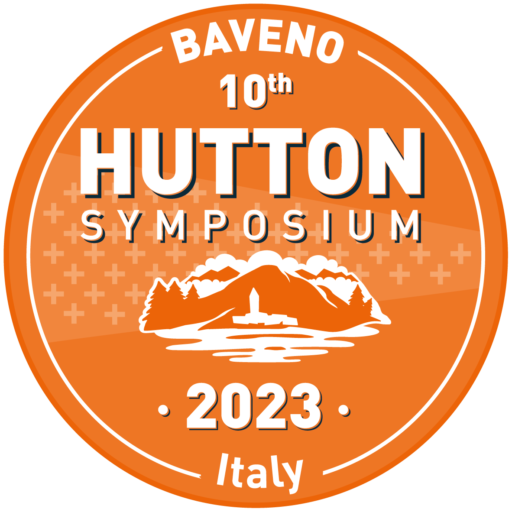
The tenth Hutton Symposium was held in Northern Italy, on the shore of the beautiful Lago Maggiore, from the 11th to the 15th of September 2023. Since its debut in Edinburgh, Scotland in 1987, the Hutton Symposium has become a very dynamic international forum to discuss pressing issues relevant to the formation and evolution of magmatic rocks, including granites s.l., but also encompassing all the different types of of plutonic and volcanic rocks that are found on Earth (and other planets)
Every four years, this event brings together leading scientists from around the world on igneous processes, ore deposits, structural geology, … and highlights the research trends in these fields. Northern Italy, on the southern foothills of the Alps, offered a wonderful location to attract scientists from the whole world, and provided easy access to some world-famous exposures on granites and related rocks. In particular, the participants were able to visit the Permian Ivrea-Verbania Zone, displaying one of the best studied tilted magmatic crustal columns, with exposures from the Moho to the volcanic rocks at the surface.
About the conference
The conference was structured in four themes, each occupying one day. In addition, a mid-conference field trip to the Ivrea Zone is included for all the participants.
Scientific themes
Theme 1: Granites in geodynamic sites, planets and time. This theme deals with the Big Picture: where and when do granites and related rocks form? What controls their differences between various sites on our planet, or indeed between planets? How did granite magmatism evolve in time, and how does it impact the nature and evolution of the continental crust?
Chairpersons: F. Bitencourt, R. Economos
Theme 2: Genesis of granitic magmas: Competing models, competing processes. This theme is about the processes that lead to the formation of granitic (s.l.) magmas, and in particular aims at discussing the various pathways that may lead to them: melting, fractionation, mixing etc. This is the right place to tackle the old issue of the respective roles of mantle and crust. Information can be gained from a range of sources from experiments, models, geochemical data and more.
Chairpersons: G. Bergantz, B. Cesare, C. Miller
Theme 3: Architecture of crustal magmatic systems and rate of magmatic processes. This theme addresses the physical shape and connectivity of magma networks at all scales, from the crust to the grain boundary and from the source to the volcano, including the plutonic-volcanic connection. We will discuss the rates of processes such as melting, melt extraction, magma motion, pluton accretion, eruption, as well as the mechanical and chemical drivers of them.
Chairpersons: P. Fiannacca, V. Memeti, M. St Blanquat
Theme 4: Fluids in and around granites. In this theme, we discuss the role of evolution of melts, supercritical fluids, etc. in particular during final cooling and solidification of plutons. We also address the textural development of granitoids. We welcome contributions on pegmatites, ore deposits, geothermal fluids, etc.
Chairpersons: C. Annen, C. Chelle-Michou, R. Weinberg
Conference format
Each of the themes included contributions in different formats:
- “Overview” talks (45 mn) given by senior researcher, summarizing the current knowledge in their field. These keep the tradition of having a “workshop” component during the Hutton conferences, which always made them very useful in particular for early stage researchers … but not only !
- “Junior” keynote talks (30 mn), focusing on key recent developments;
- Regular talks (15 mn, including questions);
- Posters.
We had more or less 2 overview and 2 keynote talks, 10 to 15 regular oral and maybe 30 posters per theme. The posters were displayed in two groups during half of the conference each: the first block (themes 1 and 2) from Sunday evening to Tuesday evening, the second (themes 3 and 4) from Wednesday to Friday evening. Coffee breaks and other displays were in the same space as the posters, offering ample opportunity to view and discuss them.
Displays, other events, etc.
In addition to the regular scientific program, many other activities occured:
- A photo exhibition of interesting or puzzling field features was displayed, and there were appointed times for those willing to discuss them and offer their interpretation. All participants were invited to submit their best photo during registration ! (Coordinators: M. de Saint-Blanquat and R. Weinberg).
- Data, maps, and thin sections from the Ivrea Zone (that we visited on Wednesday) were on display during the conference, allowing all participants to come prepared to the field, or maybe to take the discussion further in the following days (Coordination and compilation: L. Caricchi).
- Discussions happened around community animation: the possibility of launching a Diamond Open Access journal (O. Laurent); the idea to resurrect the once very successful “Eurogranite” meetings (V. Janoušek); the possibility to reanimate the dormant granite-research mailing list; plans were floated to start a discord server catering to “young” granitologists.
- A general discussion session dealing with “past and perspectives” concluded the conference. B. Collins, C. Miller and P. Ulmer were in charge, with the help of volunteers amongst the Junior Keynote Speakers.
The next Hutton
As always, we voted for the organization and location of the following Hutton conference, to be held in 2027. Bids were presented and the participants voted – the next Hutton will be in India!